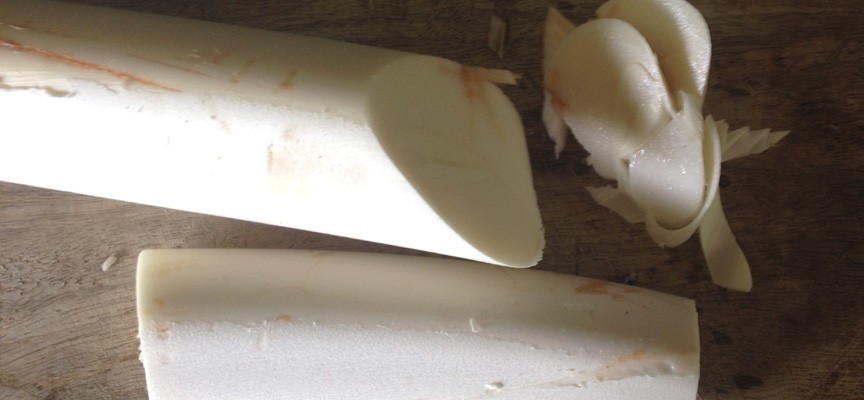 Coconut palms are known typically for their coconuts. You can eat and drink the nuts in various stages of development and they are all delicious. But did you know that you can harvest the heart from a coconut palm and eat it?
Coconut palms are known typically for their coconuts. You can eat and drink the nuts in various stages of development and they are all delicious. But did you know that you can harvest the heart from a coconut palm and eat it?
The heart of palm located where the green leaves start to bud from the trunk. Under the woody palm leaf stem is a soft, white center known as the apical bud. Removing the heart from a coconut palm will kill the tree.

A harvestable size
Eating the heart of the palm is a delicacy and obtaining a heart can be a rare occurrence. There are those times when trees need to be thinned, or they fall over, or you have no choice but to remove them from your property. You can also plant them specifically for their tender hearts.
The point is not to let them go to waste if you must remove them. Personally, I have never harvested the heart from a large, mature palm but this is certainly possible. Typically, I have removed rather small coconut palms that were on my fence line, or ones that have been growing too close to another tree.
I recommend waiting to harvest a wayward coconut palm until you absolutely need it out of the way. I left one along my fence line for years, specifically waiting for it to mature, until I needed to take it out.

Removing harder boots
If you have trees that you must clear, the best ones have a small trunk about 6-8″ wide. If they are too small, they are not really worth the effort. Remove the fronds with a machete or pruning saw. The center vertical fronds on older trees can be saved and are perfect for basket weaving.
Next cut the tree just where the frond stem meets the trunk. For larger trees, a pruning saw is best. You may find it easier to remove the woody frond boots with a machete. A few quick pulls from a saw and soon you will have the heart wrapped with various sized leaf stems.
I then take this to a truck bed or kitchen counter top and using a machete or large kitchen knife, find the edge of the leaf stem and score it on both sides. Then gently remove the leaf stem by peeling them off.

Taking leaf stems off
Continue to remove the hard, green or brown leaf stems until you start to see the white fleshed heart. It’s very delicate and it is easy to distinguish from the inedible parts because of its lack of pigment and you will find a knife quickly passes through it.
On the smaller trees, the heart will be 2″ to 3″ wide and 8″ to 10″ long. You can refrigerate this for later use or you can begin to process it by slicing it in 1″ to 1/2″ sections.
If you get to a section where your knife requires more force while cutting, taste a piece to see if it is too fiberous for eating. If so, discard along with any white palm frond leaves. The leaves have little to no flavor and have a unpalatable consistency.

Sections in a brine
Place your cut up heart into a light brine (salty) water mixture. It tends to oxidize fast and discolor if not. Also, it will extend the shelf life and can be refrigerated for later. You may also eat it immediately.
The meat of a palm frond is sweet and crunchy. They go well in salads or eaten fresh.
In various cultures the coconut is known as “the tree which provides all the necessities of life,” “the tree of a thousand uses,” and “the tree of life”.
A very honorable tree that must be grown where ever you can grow it and eaten in all appreciation.

Heart of a coconut palm

Pingback: Ngohiong - Ang Sarap